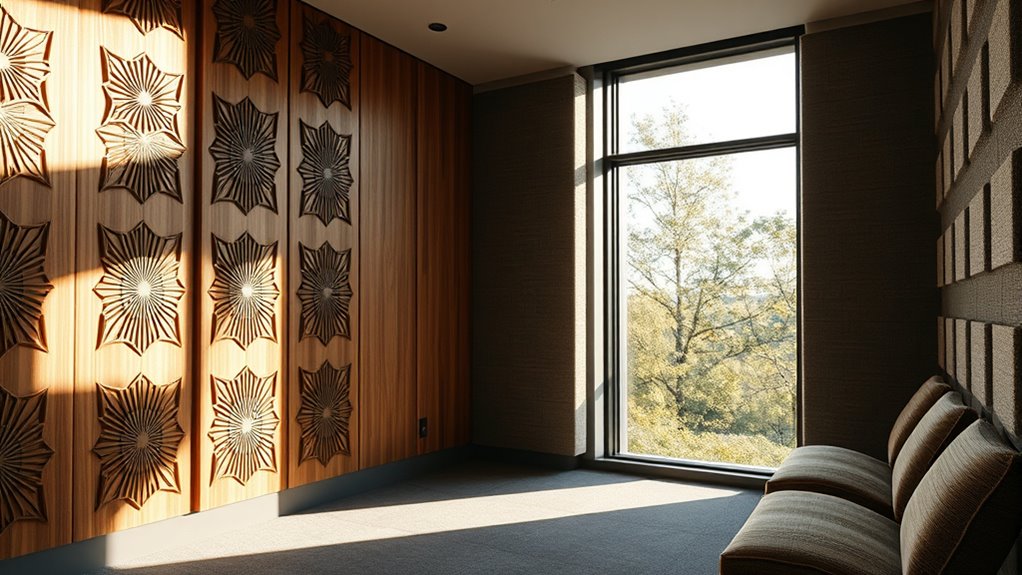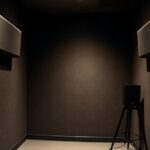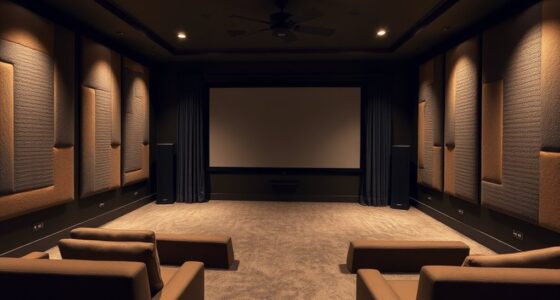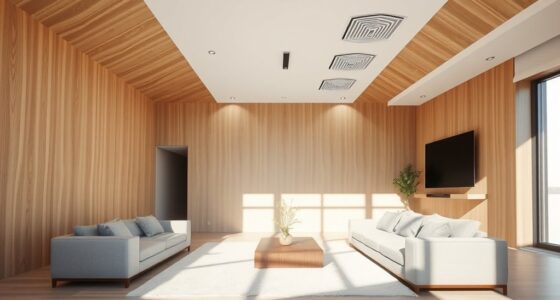In room design, diffusers scatter sound waves in multiple directions, maintaining natural liveliness while preventing echoes, making them ideal for listening and mixing areas. Absorbers, on the other hand, soak up excess sound energy, reducing reflections and reverberation for clearer audio. By understanding how these components work together, you can create a balanced acoustic environment. Keep exploring to discover how properly combining diffusers and absorbers can optimize your space’s sound quality.
Key Takeaways
- Absorbers reduce reflections and reverberation, creating a cleaner sound environment.
- Diffusers scatter sound waves to maintain room liveliness and prevent echo buildup.
- Absorbers are best placed on parallel walls and reflection points; diffusers are ideal on rear walls or ceilings.
- Combining both components balances sound clarity with natural room ambiance.
- Proper use of absorbers and diffusers enhances overall room acoustics for listening, recording, or mixing.
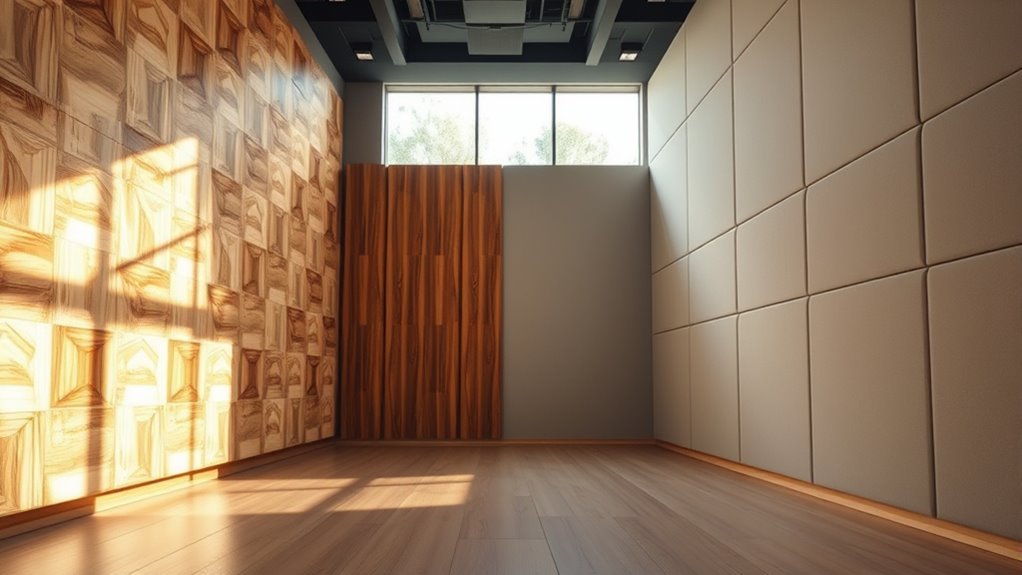
When designing a room for ideal sound quality, understanding the roles of diffusers and absorbers is vital. Both are key components of acoustic treatment, but they serve different purposes in managing sound reflection. Sound reflection occurs when sound waves bounce off surfaces, creating echoes or reverberation that can muddy audio clarity. To optimize your space, you need to control these reflections effectively. Absorbers are designed to reduce sound reflection by soaking up excess sound energy, preventing it from bouncing around the room. They’re typically made from porous materials like foam, fiberglass, or mineral wool, which trap sound waves and convert them into a tiny amount of heat. When you install absorbers, you’ll notice a decrease in reverberation time, resulting in cleaner, more focused sound.
On the other hand, diffusers serve a different purpose in acoustic treatment. Instead of absorbing sound, they scatter it in multiple directions. This scattering breaks up sound reflection, preventing distinct echoes and creating a more even sound field. Diffusers are often made from complex geometries or uneven surfaces that break up the wavefront, dispersing sound energy throughout the room. This process enhances the room’s natural acoustics by maintaining a sense of liveliness without excessive echo. When you incorporate diffusers, you preserve some of the room’s ambiance while reducing problematic reflections that can cause speech muddiness or listening fatigue. Proper placement of diffusers can also help in managing sound energy more effectively.
In practical terms, you’ll want to strategically place absorbers where sound tends to reflect most strongly, such as behind speakers or along parallel walls. These placements help tame unwanted echoes and make speech or music clearer. Diffusers are best used in areas where you want to maintain a sense of spaciousness and natural sound diffusion, such as on the rear wall of a listening room or in the ceiling above a mixing area. By combining absorbers and diffusers thoughtfully, you create a balanced environment where sound is controlled without making the room feel dead or overly lively.
Ultimately, understanding the difference between sound reflection management through absorbers and diffusion through diffusers allows you to tailor your acoustic treatment precisely. When you focus on reducing unwanted reflections with absorbers and dispersing sound with diffusers, you craft a space that enhances clarity, warmth, and overall sound quality. This thoughtful approach ensures your room supports excellent listening, recording, or mixing experiences, making it a vital part of room design.
Frequently Asked Questions
How Do Diffusers and Absorbers Differ in Sound Wave Interaction?
Diffusers scatter sound waves, promoting sound diffusion and preventing echoes, especially at mid to high frequencies. Absorbers, on the other hand, soak up sound energy, reducing reflections and controlling the overall frequency response. Your room benefits from diffusers when you want a lively, natural sound, while absorbers are ideal for creating a quieter, more controlled environment. They interact differently with sound waves, shaping your room’s acoustics effectively.
Which Is More Effective for Controlling Echo and Reverberation?
Absorbers are more effective for controlling echo and reverberation, especially since they reduce sound reflections directly. Interestingly, over 60% of acoustic treatments in professional spaces use absorbers for this purpose. You’ll find many decorative options that blend with your decor, but installation complexity varies — absorbers tend to be simpler to install than diffusers. For quick, effective echo control, absorbers are your best choice, offering both practicality and aesthetic flexibility.
Can Diffusers and Absorbers Be Combined Effectively?
Yes, you can combine diffusers and absorbers effectively to enhance your room’s acoustics. Incorporate decorative elements like textured panels or artistic diffusers for aesthetic appeal, creating acoustic layering that balances sound absorption and diffusion. This approach controls echo and reverberation while adding visual interest. By thoughtfully integrating both, you optimize sound quality and style, making your space both functional and visually appealing.
What Are the Cost Differences Between Diffusers and Absorbers?
You’ll find that diffusers generally cost more upfront than absorbers due to their complex design and installation costs. Absorbers are simpler and cheaper to produce and install. Durability factors also influence costs; diffusers often last longer with proper maintenance, while absorbers may degrade faster. Overall, absorbers are budget-friendly, but diffusers can be a better investment for long-term durability and sound quality.
How Do Room Size and Shape Influence Choice?
Think of your room as a canvas; its size and shape paint the picture of your acoustics. If your space is small or irregular, absorbers help tame echo and noise, creating clarity. For larger or uniquely shaped rooms, diffusers scatter sound evenly, enhancing the aesthetic integration while improving room acoustics. Your choice should match your room’s dimensions, turning sound challenges into harmonious art.
Conclusion
So, next time you’re tempted to choose between diffusers and absorbers, remember this: sometimes, quiet and dead might seem appealing, but a lively space needs a bit of chaos. Ironically, the best room design balances both—giving you clarity without silence, energy without chaos. After all, in acoustics as in life, a little disorder can be just what you need to truly feel at home. Don’t settle for silence—embrace the perfect mix.
